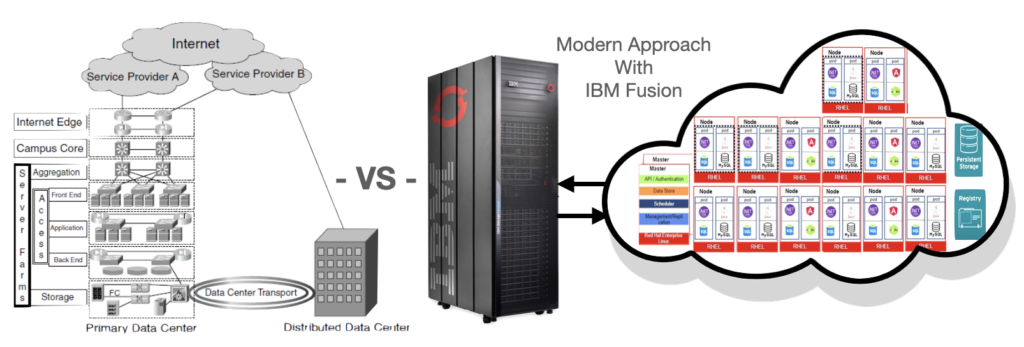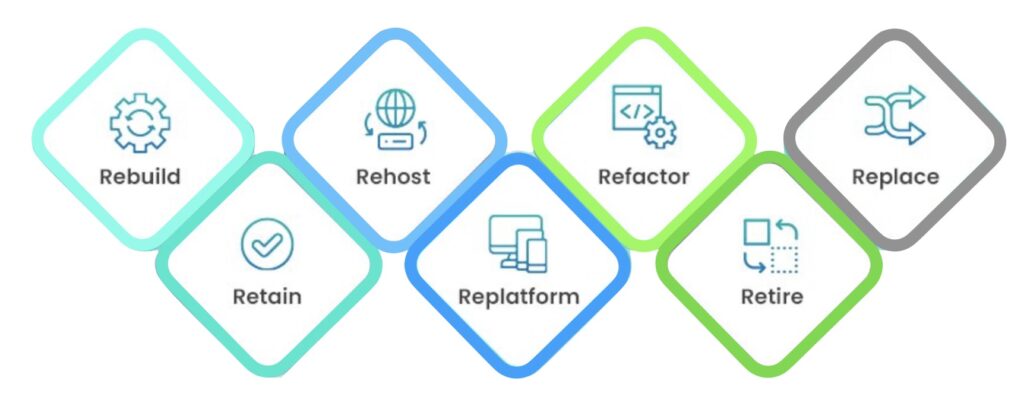In the ever-evolving landscape of cybersecurity threats, organizations face the constant challenge of protecting their systems and applications from vulnerabilities. One critical aspect of maintaining a secure environment is effective system patch management. Nearly 60% of cyber attack victims said installing an available patch would have prevented their breach, and 39% said they knew about a vulnerability before an attack occurred but never addressed it. There are many reasons why patching can not be done quickly so lets take a look at the benefits of system and application modernization to address administration and operational activities driven by cybersecurity vs the cost of staying staying with a traditional architecture.
When comparing a traditional topology like the one below with something like IBM’s Fusion and OpenStack while considering the operational effort to keep up with the demand of updating, monitoring systems and networks for cybersecurity, we find ourselves with an impossible task. The cost of trying to keep current even with the help of system automation does not work, so we compromise and prioritize our efforts, leaving vulnerable environments for cyber criminals to exploit.

System modernization involves upgrading or migrating existing infrastructure, hardware, and software components to newer versions and or platforms. It focuses on enhancing performance, scalability, as well as security. Typically application modernization aims to improve applications by updating their architecture, integrating new functionalities, and optimizing performance, however an important byproduct of modernization is a more resilient infrastructure that operationally scales while laying the groundwork to address cybersecurity.
OpenShift is a containerization platform that provides an environment for developing, deploying, and managing containerized applications. It offers benefits such as scalability, portability, and ease of management. One of the key differentiators the OpenShift’s container-based approach brings is its seamless patch management abilities where updates can be applied to containers independently, without affecting the entire system thus reducing vulnerability exposure by keeping current. This changes the threat protection metrics allowing organizations to pursue a more aggressive cyber defense, encompassing more of the environment that would otherwise be susceptible to cyber attacks and data breaches.
Modernizing systems and applications helps address security gaps and vulnerabilities present in outdated architecture, frameworks, and libraries reducing the overall attack surface. Upgrading infrastructure and optimizing applications can also enhance performance, enable faster response times and reduce the risk of cyberattacks. An important aspect of deploying containerized applications is OpenShift’s orchestration capabilities which simplify application deployment, monitoring, management, and streamlining the patching processes enabling the ability to keep systems current.
System and application modernization, along with the adoption of containerization, will require initial investments in hardware, software licenses, training, and migration efforts, but the resulting reduction in downtime, improved efficiency, and the ability to minimize security breaches, all lead to cost savings.

There are many reports looking at Application Modernization projects so depending on you vendors your ROI will vary but a typical 3 year ROI returns 200-250% on investment driven by a 50% increase in application development speed with a 40% reduction in app-dev related costs. Each company will have to evaluate their current strategy and look at the most cost effective approach to take. Of course every application is not going to fit nicely and may come with some challenges but it’s the end result that sets us up for success.
With the many options to transition to containers here are some common migration methods and approaches to consider.
- Lift and Shift – Re-host: This method involves packaging the existing application as-is into a container without making significant modifications to the application code or architecture. The application is containerized, allowing it to run within a container runtime environment. This approach provides portability and allows for easy deployment and scaling of the application.
- Refactoring: Refactoring involves making changes to the application code or architecture to optimize it for containerization. This may include modularizing the application, separating dependencies, and configuring it to work with container-specific features. Refactoring helps maximize the benefits of containerization, such as scalability, resource efficiency, and isolation.
- Rebuilding: In this approach, the application is rebuilt from scratch using container-native frameworks and tools. This typically involves rewriting the application code using container-specific technologies like Docker files, Kubernetes YAML manifests, or platform-specific APIs. Rebuilding the application allows for tighter integration with container orchestration platforms and takes full advantage of container capabilities.
- Hybrid Approach: A hybrid approach combines elements of lift and shift, refactoring, and rebuilding. It involves identifying parts of the application that can be lifted and shifted into containers without modifications, while other parts may require refactoring or rebuilding. This approach offers flexibility and allows organizations to prioritize the containerization effort based on the criticality and complexity of different application components.
There are several tools and platforms available that can help automate the process of migrating applications to a containerized environment. These tools typically provide features like image creation, dependency management, application discovery, and deployment automation. Organizations often start with small-scale pilot projects to gain experience and confidence in containerization. They select less complex applications or specific components of larger applications as initial targets. Once successful, they can expand the containerization effort to more critical or complex applications using lessons learned from the pilot projects.
System and application modernization, coupled with the adoption of technologies such as OpenShift containers, offers significant benefits for addressing cybersecurity patch management. While there are upfront costs associated with making the change, the enhanced security, improved performance, simplified management, and long term cost savings make it a worthwhile investment. Staying with the current architecture may expose organizations to compatibility issues, limited support, and cumulative risks. The answer my be to step back and consider a comprehensive approach that is designed with security in mind rather than trying at adapt your current design and remember that the most dangerous phrase in business is “This is the way it’s always been done”……

